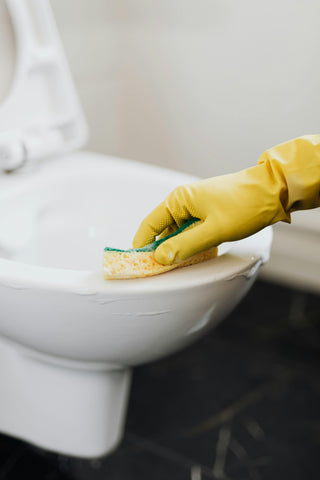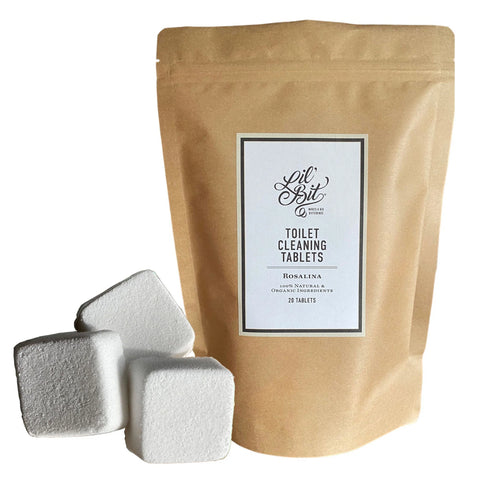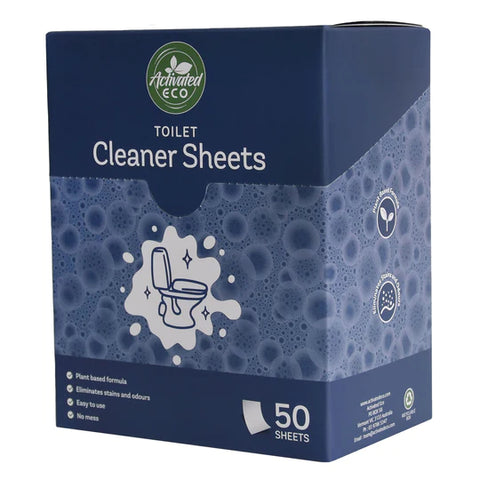How to Remove Rust Stains From Toilet
Rust stains can be stubborn and disturb the cleanliness of your bathroom. That's why we're about to walk you through how to remove rust stains from toilet, highlighting key products and nifty tricks.
Some of these methods include the use of cream of tartar, light abrasives, white vinegar, and citric acid. But the best solution is our natural toilet sheets and tablets.
Afterwards, we'll delve into what causes these pesky stains, how often you should clean them, and additional tips to keep your toilet rust-free.
Here's how to clean toilet bowl stain formations caused by rust.
What this article covers:- What You Will Need
- Instructions
- Utilise Citric Acid
- How Often To Clean Rust Stains On Toilets?
- Additional Tips For Addressing Rust Stains
What You Will Need
Tackling rust stains in your toilet doesn't require an arsenal of harsh chemicals or expensive tools. In fact, you might find that you already have most of what you need right at home. Here's a rundown of the essentials to get you started on removing those stubborn rust stains:
- Cream of tartar
- Light abrasives like baking soda
- White vinegar
- Citric acid (lemon juice)
- Toilet brush or sponge
- Protective gloves
- Clean cloth or rag
- Activated Eco toilet cleaner sheets
- Rosalina toilet cleaning tablets
Instructions
Use Cream Of Tartar
Cream of tartar is a potent ally against rust stains. A byproduct of winemaking, its acidic properties make it an excellent choice for breaking down rust without damaging porcelain surfaces.
Start by making a paste with cream of tartar and a small amount of water. Apply this paste directly onto the rust stains in your toilet bowl. Then allow it to sit for an hour.
After waiting, scrub the treated areas with a toilet brush or sponge, focusing on the stained spots. Flush the toilet to rinse away the paste and the loosened rust stains.
Try Light Abrasives
For rust stains that are a bit more stubborn, light abrasives like baking soda can be your go-to solution. Sprinkle a generous amount directly onto the wet stains.
Using a damp toilet brush or sponge, scrub the stains in a circular motion, applying a bit of elbow grease to help lift the rust.
You might need to add a bit more water to create a paste-like consistency, enhancing the abrasive action. After thoroughly scrubbing, let the mixture sit for a few minutes to maximise its cleaning power before flushing the toilet.
Incorporate White Vinegar
White vinegar is a versatile cleaning agent that can effectively dissolve rust stains thanks to its acid content. To use, fill a spray bottle with undiluted white vinegar and generously spray the rust-stained areas of your toilet bowl.
For more severe stains, you can soak a few paper towels in vinegar and place them directly on the stains, allowing the vinegar to cling to the surfaces for better penetration.
Let the vinegar work its magic for at least 30 minutes, or even overnight for deep-set stains. After the soaking period, remove the paper towels (if used) and scrub the area with a toilet brush.
This method works no matter the stain colour, making it the answer to those queries about how to get rid of brown stains in toilet bowl, how to remove black stains from toilet bowl, and how to remove yellow stains from toilet.
Utilise Citric Acid
Citric acid is found in lemons. Its natural acidity breaks down rust. For a simple application, cut a lemon in half, dip it in baking soda or salt, and rub the cut side directly against the rust stains.

Let it sit for a few hours, or overnight for tough stains, to allow the citric acid to dissolve the rust. The, as with the other methods, use a toilet brush to loosen the debris.
Use Activated Eco Toilet Cleaner Sheets
Looking for the best toilet cleaner for tough stains? Our plant-based toilet cleaner sheets remove rust stains without hassle.Made with the environment in mind, they provide a highly effective clean without harsh chemicals.
To use, simply select one sheet from the eco-friendly box. Place it directly in the toilet bowl, allowing it to dissolve and release its cleaning agents.
Once dissolved, use a toilet brush to spread the formula evenly across the bowl, paying special attention to areas with rust stains. The sheet's rapid dissolution technology activates the formula quickly, targeting rust stains in a flash.
Not only do these sheets tackle tough stains, but they also combat odours, leaving your bathroom smelling as clean as it looks. They are available in pack sizes of 50, 100, 200, and 300. And they'll arrive just in time for your next clean, thanks to the convenient subscription plan.
Pick Rosalina Toilet Cleaning Tablets
When it comes to cleaning toilet stains, Rosalina toilet tablets provide a convenient and effective solution. Crafted with an eye towards a waste-free lifestyle, they are made with plant-derived ingredients that work well without the harshness of commercial cleaners.
Pulling back the packaging, we present a formulation of sodium hydrogen carbonate, food-grade citric acid organically certified, palm-oil- free Australian organic Castile soap, and ACO-certified organic Rosalina essential oil extracted from melaleuca ericifolia leaf.
To use them, simply drop one tablet into the toilet bowl. The tablet will fizz and dissolve, releasing cleaning agents that target rust stains and leave your toilet sparkling.
For best results, allow the tablet to fully dissolve and let the solution sit for a few minutes before scrubbing with a toilet brush.
What Causes Rust Stains?
Rust stains in toilets are primarily caused by high iron content in the water supply. When iron-rich water is exposed to oxygen, it oxidizes, resulting in rust.
Over time, these stains can become more pronounced, adhering to the porcelain surfaces of the toilet and becoming increasingly difficult to remove.
The presence of rust stains is not just a cosmetic issue; it can also indicate underlying problems with your water supply or plumbing system. Corroding pipes made of iron or steel can shed rust particles into the water, which then deposit on the surfaces of your toilet bowl..
How Often to Clean Rust Stains on Toilets?
The frequency depends on the severity of the staining. For mild rust stains, a regular cleaning schedule of once a week may suffice. However, in areas with high iron content in the water or for toilets that are used less frequently, more frequent cleaning—possibly two to three times a week—may be necessary.
Our research indicates that rust stains can etch into the porcelain over time if left untreated, making them much harder to remove and potentially causing permanent damage. Incorporating rust stain removal into your regular cleaning routine can prevent this from occurring.
Additional Tips for Addressing Rust Stains
Beyond the direct methods of removing rust stains from toilets, there are several additional strategies that can help prevent these stains from forming in the first place, or at least make them easier to manage.
Keep Things Dry
Moisture contributes to the oxidation process, accelerating the formation of rust stains. By keeping the toilet and surrounding areas as dry as possible, you can slow down the rusting process.
This includes wiping down wet surfaces and ensuring good ventilation in the bathroom to reduce humidity levels.
Replace Old Pipes
Our findings show that old iron pipes are prone to corrosion, which can release rust into your water supply, leading to stains. Replacing old iron pipes can reduce the risk of rust stains, improving the overall quality of your water supply.
Avoid Chlorine Bleach
While chlorine bleach is a common cleaning agent, it can actually exacerbate rust stains if used regularly. Based on our observations, this is because chlorine can react with iron in the water, increasing the risk of rust formation.
Opting for alternative cleaning agents, like our star options, can help maintain a rust-free toilet.
Conclusion
Mastering the art of removing rust stains can turn a dreaded chore into a satisfying task.
Our journey through this article has equipped you with a comprehensive toolkit and knowledge base, from the essentials like cream of tartar and white vinegar to innovative solutions like Activated Eco's toilet cleaner sheets and Rosalina toilet cleaning tablets.
We've delved into the causes behind these stubborn stains, outlined how often you should wage war against them, and shared additional strategies to keep your throne fit for royalty.
Our exploration has not only highlighted practical solutions, but also underscored the significance of eco-friendly options in preserving our planet's health. Vist Activated Eco and transform your toilet cleaning routine.
If you want to learn more, why not check out these articles below:
- How to Remove Hard Water Stains From Toilet
- How to Clean a Dirty Toilet Without Scrubbing
- How to Remove Toilet Bowl Ring Stains
- How to Get Rid of Stains Under Toilet Rim
- How to Clean Poop Stains From Toilet Bowl
- Best Clothes Pegs
- How to Get Peg Marks Out of Clothes
- Pegs That Don't Mark Clothes
- Best Clothes Pegs for Windy Conditions
- How to Avoid Peg Marks on Clothes
- Do Stainless Steel Pegs Rust?
- Essential Oils for Dryer Balls
- How Many Dryer Balls Per Load
- Are Dryer Balls Worth It
- How to Use Dryer Balls


